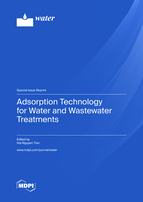Adsorption Technology for Water and Wastewater Treatments
A special issue of Water (ISSN 2073-4441). This special issue belongs to the section "Wastewater Treatment and Reuse".
Deadline for manuscript submissions: closed (30 June 2023) | Viewed by 29856
Special Issue Editor
Interests: adsorption; adsorption mechanism; water treatment; emerging pollutant; advanced oxidation process; catalysis; fenton-like reaction; photocatalysis; materials chemistry and physics; volatilization of organic compounds; modelling
Special Issue Information
Dear Colleagues,
The presence of pollutants (i.e., emerging contaminants, radionuclides, potential toxic metals, dyes, etc.) in water has a negative impact on the environment and presents a potential health risk for inhabitants. Among the existing technologies (i.e., advanced oxidation process, membrane filtration, biodegradation, etc.) for removing them from water, adsorption has garnered some interests due to its low cost and fast removal. The development of advanced materials and their application for water treatments have caught research attention recently.
The Special Issue (SI) aims to establish updated information on adsorption technology for water and wastewater treatments. The submissions selected for this SI should focus on: (1) applying reality technology for water and wastewater treatments and (2) exploring detailed adsorption mechanisms by current data (i.e., comparing the changes of the properties of adsorbents before and after adsorption using appropriate techniques).
Adsorption studies should include the effects of some important operating parameters (contact time, pH, NaCl, adsorbate concentration, co-existence of other competitive solutes, temperature, etc.) and the cycles of adsorption/desorption. Studies of continuous fixed-bed column adsorption are always encouraged.
Various synthetic and natural materials, composites, and nanomaterials are well fitted to the scopes of this SI. The targets of removing emerging pollutants are a priority compared to other traditional pollutants. The parameters of the models used in adsorption isotherms and kinetics should be obtained from non-linear methods.
Review articles are encouraged if they are critical or comprehensive type.
Dr. Hai Nguyen Tran
Guest Editor
Manuscript Submission Information
Manuscripts should be submitted online at www.mdpi.com by registering and logging in to this website. Once you are registered, click here to go to the submission form. Manuscripts can be submitted until the deadline. All submissions that pass pre-check are peer-reviewed. Accepted papers will be published continuously in the journal (as soon as accepted) and will be listed together on the special issue website. Research articles, review articles as well as short communications are invited. For planned papers, a title and short abstract (about 100 words) can be sent to the Editorial Office for announcement on this website.
Submitted manuscripts should not have been published previously, nor be under consideration for publication elsewhere (except conference proceedings papers). All manuscripts are thoroughly refereed through a single-blind peer-review process. A guide for authors and other relevant information for submission of manuscripts is available on the Instructions for Authors page. Water is an international peer-reviewed open access semimonthly journal published by MDPI.
Please visit the Instructions for Authors page before submitting a manuscript. The Article Processing Charge (APC) for publication in this open access journal is 2600 CHF (Swiss Francs). Submitted papers should be well formatted and use good English. Authors may use MDPI's English editing service prior to publication or during author revisions.
Keywords
- adsorption
- water treatment
- wastewater treatment
- adsorption mechanism
- adsorption modelling
- artificial intelligence
- machine learning
- statistical physics
- emerging pollutant






